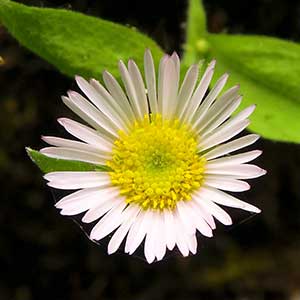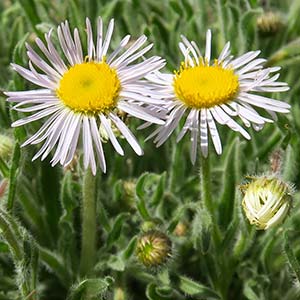|
Gorge fleabane, Oregon fleabane
|
Snake River fleabane, white cushion fleabane
|
| Perennial from a stout, woody base and root, the lax stem 5-15 cm. long, covered with glands and loose, sticky hairs. |
Perennial from a tap-root, 3-12 cm. high, the stem covered with very unequal, spreading hairs. |
Basal leaves tufted, spatulate to obovate, coarsely toothed or incised, up to 9 cm. long and 2.5 cm. wide; cauline leaves well developed, broadly lanceolate to ovate or elliptic, up to 4 cm. long and 1 cm. wide. |
Leaves nearly all in a basal cluster, finely stiff-hairy, linear or linear-oblanceolate, up to 4 cm. long and 2 mm. wide. |
Heads 1-several in a leafy inflorescence, the disk 9-13 mm. wide; involucre 5-7 mm. high, the bracts loose, equal, thin and green; rays 30-60, pink or white to bluish; disk corollas 3.4-4.7 mm. long, yellow; pappus simple, of 15-20 bristles that are curled and twisted above. |
Heads solitary; involucres 5-7 mm. high, with spreading short hairs and often glandular as well; rays 30-60, white, pistillate, becoming pinkish, 5-10 mm. long and 1.5-2.3 mm. wide; disk flowers yellow; pappus of 15-25 capillary bristles. |
|
|
|
|
| May-September |
May-July |
| Moist shady cliffs and ledges. |
Dry, rocky hillsides at low to middle elevations. |
Occurring in the Columbia River Gorge in Washington; Columbia River Gorge in Washington to adjacent Gorge area in Oregon.
|
Occurring east of the Cascades crest in the Snake River area in southeastern Washington; southeastern Washington to southeastern Oregon, east to southwestern Idaho.
|
| Native |
Native |
| Threatened in Washington (WANHP) |
Sensitive in Washington (WANHP) |
E. acris, E. aliceae, E. annuus, E. aureus, E. basalticus, E. bloomeri, E. caespitosus, E. chrysopsidis, E. compositus, E. corymbosus, E. davisii, E. disparipilus, E. divergens, E. eatonii, E. elatus, E. filifolius, E. flettii, E. glacialis, E. howellii, E. inornatus, E. karvinskianus, E. leibergii, E. linearis, E. lonchophyllus, E. nivalis, E. peregrinus, E. philadelphicus, E. piperianus, E. poliospermus, E. pumilus, E. salishii, E. speciosus, E. strigosus, E. subtrinervis |
E. acris, E. aliceae, E. annuus, E. aureus, E. basalticus, E. bloomeri, E. caespitosus, E. chrysopsidis, E. compositus, E. corymbosus, E. davisii, E. divergens, E. eatonii, E. elatus, E. filifolius, E. flettii, E. glacialis, E. howellii, E. inornatus, E. karvinskianus, E. leibergii, E. linearis, E. lonchophyllus, E. nivalis, E. oreganus, E. peregrinus, E. philadelphicus, E. piperianus, E. poliospermus, E. pumilus, E. salishii, E. speciosus, E. strigosus, E. subtrinervis |
| |



